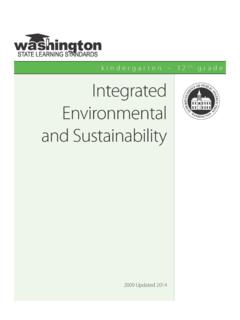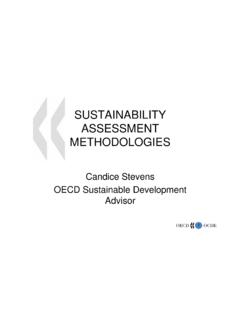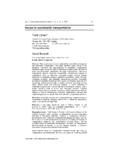Transcription of Sustainability impact assessment: an introduction - OECD
1 Sustainability impact assessment : AN introduction SOURCE: GUIDANCE ON Sustainability impact assessment (OECD 2010) Sustainability impact assessment : an introduction The purpose of this document This document offers a general introduction to sustainable impact assessment (SIA). SIA is an approach for exploring the combined economic, environmental and social impacts of a range of proposed policies, programmes, strategies and action plans. Such assessments can also assist decision making and strategic planning throughout the entire policy cycle. The document is aimed at helping policy makers to increase their understanding of the basic elements, processes and multi-dimensional nature of SIAs. It intends to increase awareness of the potential of SIA for developing more sustainable policies, strategies and action plans within OECD member countries. It is hoped that it will stimulate policy makers to implement or revisit their SIAs within their own policy and institutional context.
2 The document gives a general outline of what an SIA is, why it is useful, its core principles and methodologies, and its main challenges. It is not exhaustive, and neither is it a technical how to guide for practitioners to follow when implementing an SIA. Government authorities at different levels (national, regional, local) can use this document as the basis for developing a more tailored guide for reviewing the Sustainability impacts of proposed policies and action plans. In the following chapters, we set out the steps involved in a typical SIA. These are illustrated with actual examples of methodologies used by several OECD member countries and other institutions. These examples show only some of the various possibilities and methodologies available and in use. The examples used in this document are based on the three pillars of sustainable development: economic, environmental and social.
3 However, visions of sustainable development are evolving, particularly when governments strive to establish sustainable development strategies and wish to fully integrate Sustainability in all policy development. Some countries adopt a more integrated approach that goes beyond the idea of the three pillars and encompasses systemic and systematic sustainable development goals for policy development (in line with, for instance, Agenda 21 adopted at the 1992 United Nations Conference on Environment and Development the Earth Summit). What is an SIA? An SIA has two main functions: (i) it is a methodological soft policy instrument for developing integrated policies which take full account of the three sustainable development dimensions and which include cross-cutting, intangible and long-term considerations; and (ii) a process for assessing the likely economic, social and environmental effects of policies, strategies, plans and programmes before they have been formulated (ex ante).
4 It has some important principles: Sustainability in SIA means that all three sustainable development aspects are fully integrated into the assessment . This is not the case with other types of impact assessments (such as regulatory impact assessments, or environmental impact assessments, see Box ). Integrating sustainable development into policies means considering both short-term and long-term effects what seems to be beneficial in the short term can be devastating in the long term. There is a risk that short-term priorities take precedence over longer-term perspectives and effects (think of health risks or depletion of ecosystems). Another element that needs to be considered is spatial impact and possible conflicts between global, Sustainability impact assessment : AN introduction SOURCE: GUIDANCE ON Sustainability impact assessment (OECD 2010) regional and local objectives in policy making, both environmental and socio-economic.
5 A focus beyond numbers. There is a risk that hard forms of analysis, such as cost-benefit analysis and monetisation, prevail over qualitative and soft forms of analysis and participatory approaches. This is especially problematic in relation to environmental , social and other non-market considerations. SIA uses a variety of tools and methodologies to capture the less readily monetised aspects of Sustainability . Stakeholder involvement. Participation by stakeholders ensures input on the possible impacts (direct or indirect) and trade-offs from different perspectives and disciplines. This increases awareness of the wider implications of policies and the range of issues affected, and counterbalances the methodological limits to monetising impacts. At strategic planning levels, we usually face uncertainties in impact predictions and we touch on value questions which cannot be solved solely by expert knowledge (OECD, 2008b).
6 Furthermore, stakeholder participation allows for greater transparency in the policy process and its underlying assumptions and considerations, and creates more sustainable and consensual policy solutions. Participation should occur throughout the SIA process. While planning stakeholder participation, it is crucial to promote a multi-disciplinary, multi-perspective and bottom-up approach. We must ask ourselves if we have a balance between gender, different generations, spatial (global, national, local) and sectoral perspectives do we have all the necessary disciplines on board, and how can we stimulate stakeholder involvement? Transparency and accountability. The overall goal of an SIA is to create integrated policies which take full account of the sustainable dimensions, intangible, spatial and long-term considerations and unintended side-effects.
7 This implies transparency and accountability at different levels, over who is involved, the procedures and methodologies used, and the reasons for the chosen mitigation options and solutions. SIAs should therefore provide all this information and stimulate reflection and learning among all those who participate. A match between level of detail and policy impact . The decision to undergo an SIA has to be based on the principle of proportionate analysis , in which the depth and scope of the impact assessment is matched to the significance, political and legal nature, and sectoral context of the policy proposal. This should not only refer to the depth and scope of the analysis of an action s impacts, but also to the choice of which steps in the SIA process need to be emphasised, the type of impacts and mitigation options to be examined, and the provisions for monitoring and evaluation (The Evaluation Partnership, 2007).
8 Clear lines of responsibility. To embed the SIA within the institutional set-up and its operations, even when using simple methods or a quick scan version of the SIA, clear procedures need to be established on timing, who will do what, for what purpose and with what resources. It needs to be clear who is responsible for which steps in the SIA and the decision-making process, what methods, tools and indicators will be used, which stakeholders and experts have to be involved and in what way, and how the results will be presented and to whom. Furthermore, establishing an SIA within the policy-making process may imply several adaptations to the institutional setting. For instance, new types of stakeholder networks or multi-sector advisory bodies may need to be established, and data collection techniques and specific measurement tools may need to be developed and clearly allocated to neutral entities ( research bodies, national planning bureaus, etc.)
9 It may also require project management systems within the institutional and administrative context, involving plan, do, check, act cycles, including monitoring. Sustainability impact assessment : AN introduction SOURCE: GUIDANCE ON Sustainability impact assessment (OECD 2010) In carrying out an SIA, a number of questions will have to be answered in the preliminary stage in order to clearly establish the nature and goals of the initiative. For instance: What is the nature and scale of the issue(s), how is it evolving, and who is most affected by it? What are the views of the stakeholders concerned? What are the policy objectives and what problems need to be addressed or solved? What are the likely impacts (social, economic, ecological, and institutional) of the policy options? What are the possible unintended (secondary) side-effects?
10 What changes in the target group s behaviour are desired? Box Other types of impact assessments There are many different types of impact assessments and related assessment methodologies, social-accounting and input-output matrix, cost-benefit analysis, modelling, forecasting and back casting, including regulatory, environmental , trade, etc. These approaches evaluate a proposed policy or project by assessing its impacts on selected factors. Regulatory impact analysis (RIA), which is amongst the oldest and most common form of impact assessment used in OECD member countries, examines the costs and benefits of complying with proposed regulations (OECD, 2008a). Competition assessment reviews the effects of laws and regulations on competition in the marketplace (OECD, 2007a). environmental impact assessments (EIA) predict the possible environmental impacts of specific projects, while strategic environmental assessments (SEA) examine those of broader policies and programmes (OECD, 2006a).















